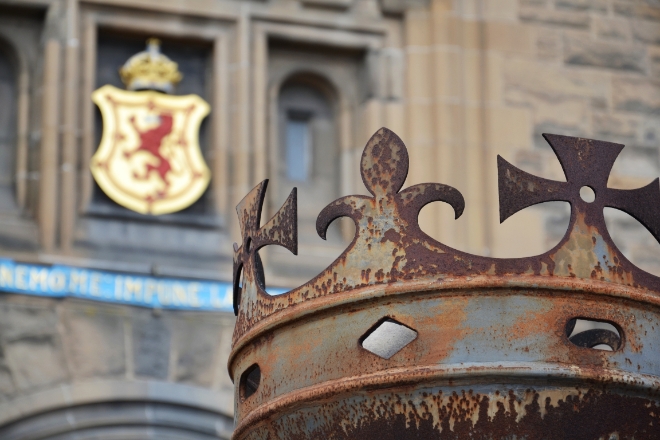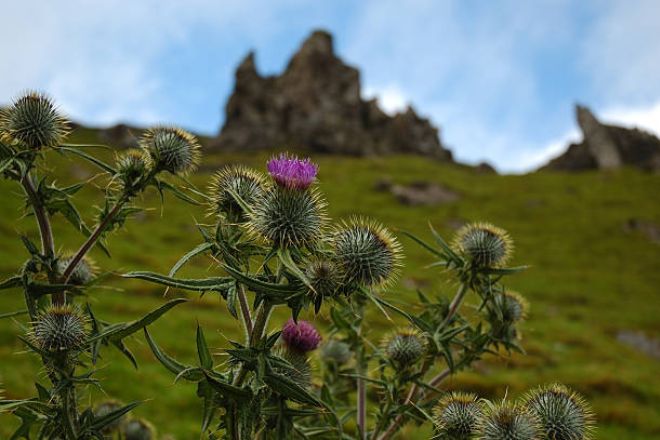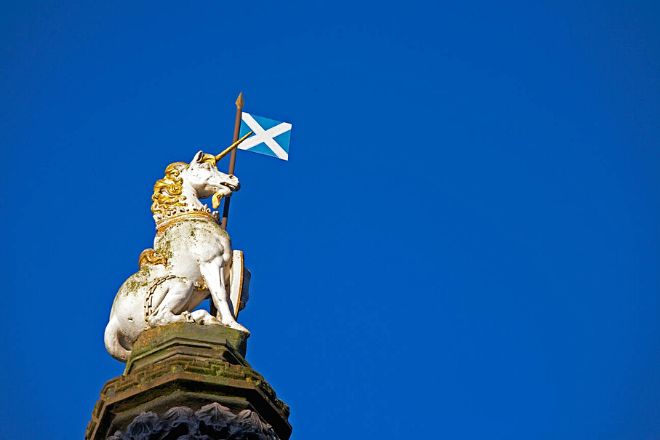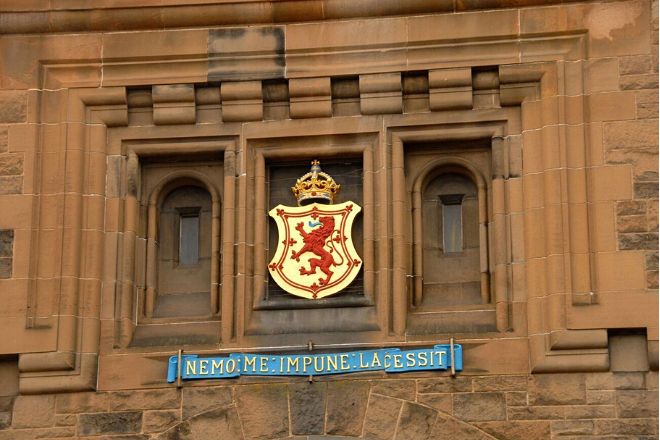
Here are some of the most iconic Scottish symbols that have stood the test of time and continue to hold significant meaning in Scotland.
The Scottish Saltire, representing the cross of Saint Andrew, Scotland’s patron saint, dates back to his crucifixion on an X-shaped cross in the 1st century AD. Legend states that during a battle in 832 AD, King Óengus II saw the saltire in the sky after praying for victory, leading to a Scottish win and St. Andrew being declared the patron saint.
The Saltire Flag appeared on Scottish soldiers’ tunics in the 14th century, and the first printed image of a St. Andrew’s cross flag appeared in 1503. By 1542, it was shown with a blue field. During the Jacobite Uprising of 1745-46, rebels wore bluebonnets with A Wearable Saltire.
Today, the Saltire remains a widely recognized symbol of Scotland, appearing on everything from Kilt Pins to Belt Buckles, from street signs, and is also used in contemporary art and design, such as in the work of Scottish artist Peter Doig. also they had Sporrans made out with the Saltire Style.
The Thistle, an enduring emblem of Scotland, has roots tracing back to the 13th century under Alexander III. It first appeared on silver coins minted by James III in 1470 and today symbolizes Scotland’s esteemed Order of the Thistle.
Featured in the Royal Coat of Arms, the thistle also inspired the motto, “Nemo me impune lacessit” (“No one harms me with impunity”). Legend links the thistle to the 1263 Battle of Largs, highlighting its association with Scottish resilience and defiance against oppression.

The Rampant Lion, a cherished symbol, features prominently on the Royal Banner of Scotland, known as Bratach rìoghail na h-Alba in Gaelic and Ryal banner o Scotland in Scots. This golden flag is officially reserved for the King of Scots and Great Officers of State, representing the Sovereign. The banner depicts a red lion with blue tongue and claws on a gold background, surrounded by a floral border.
Used since King William I’s reign, the Lion Rampant has symbolized Scotland for centuries. King Alexander II adopted it around 1222, with Alexander III adding the floral border. Since James VI became the English and Irish monarch in 1603, the Heraldic Lion has represented Scotland in British royal arms and banners.
The unicorn is a key symbol in Scottish culture, first appearing on King Kenneth MacAlpin’s coat of arms and later used by King William I to represent strength, purity, freedom, and protection. In folklore, it is a mystical creature with healing powers. As Scotland’s national animal, it has been on the royal coat of arms since the 15th century.
Unicorn statues at the Scottish Parliament, commissioned by Queen Elizabeth II in 1999, symbolize unity and independence. Today, the unicorn remains a celebrated emblem in Scottish culture, featured in events like the Highland Games.

The Honours of Scotland, also known as the Scottish Crown Jewels, are a collection of royal regalia that include the crown, sceptre, and sword of state. The Honours of Scotland are the oldest surviving set of crown jewels in Europe and have been used in Scottish coronations since the 15th century.
The Honours of Scotland were hidden away during the English Civil War and were not rediscovered until 1818. They are now on display in Edinburgh Castle, where they can be seen by the public.

Tartan, a textile pattern of intersecting stripes, originated in medieval Scotland and became a cultural symbol, representing clans and regions. The Scottish Register of Tartans records all patterns, highlighting their historical significance. Beyond tradition, tartan is a global fashion statement seen in Tartan Kilts, Tartan Skirts, and Kilt Accessories, and features in modern fashion, interior design, and commercial products like whisky bottles and souvenirs. Its rich history and versatility make tartan an enduring symbol of Scottish heritage.
Celtic symbols are not exclusively Scottish, as they are part of a broader cultural tradition that spans several countries in Europe. However, many Celtic symbols, such as the Scottish thistle and the Celtic knot, have become closely associated with Scotland and its culture.
Some Scottish symbols commonly associated with strength are the Lion Rampant, the Scottish thistle, and the Saltire. These symbols represent different aspects of Scottish identity and heritage, including historical power, resilience, and national pride.
The Scottish symbol for family is the Celtic knot, which is a type of knotwork that features interlacing patterns and has no beginning or end. The Celtic knot is often used to represent the interconnectedness of family and the continuity of life. It is a popular motif in Scottish art, jewelry, and tattoos.
Scotland’s national fruit is the raspberry. The country is known for producing high-quality raspberries, which are used in a variety of dishes and desserts, including the traditional Scottish dessert, cranachan. The raspberry was officially declared as Scotland’s national fruit in 2009.
The traditional symbol of Scotland is the thistle, a prickly purple flower that represents resilience, courage, and loyalty.
Input your search keywords and press Enter.
